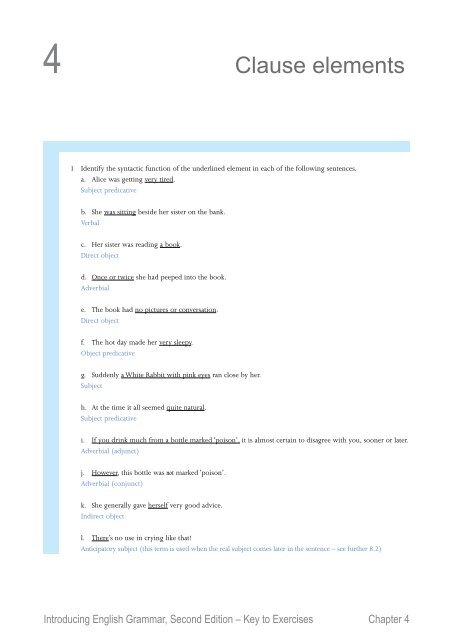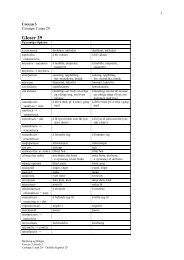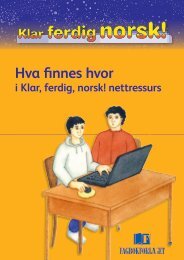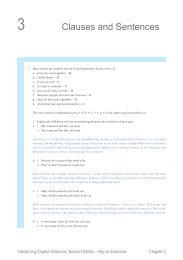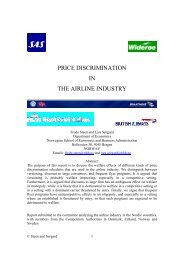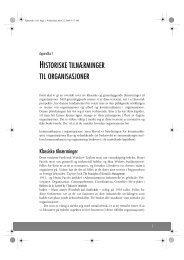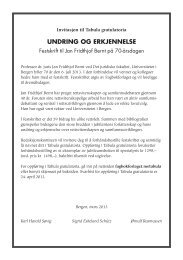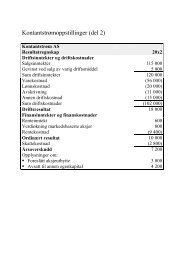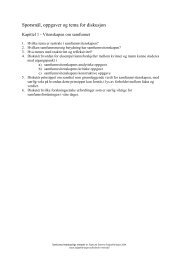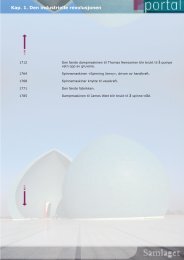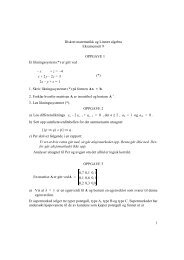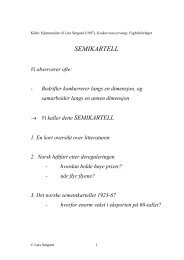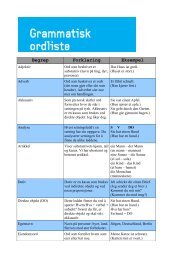Clause elements - Fagbokforlaget
Clause elements - Fagbokforlaget
Clause elements - Fagbokforlaget
Create successful ePaper yourself
Turn your PDF publications into a flip-book with our unique Google optimized e-Paper software.
4 <strong>Clause</strong> <strong>elements</strong><br />
1 Identify the syntactic function of the underlined element in each of the following sentences.<br />
a. Alice was getting very tired.<br />
Subject predicative<br />
b. She was sitting beside her sister on the bank.<br />
Verbal<br />
c. Her sister was reading a book.<br />
Direct object<br />
d. Once or twice she had peeped into the book.<br />
Adverbial<br />
e. The book had no pictures or conversation.<br />
Direct object<br />
f. The hot day made her very sleepy.<br />
Object predicative<br />
g. Suddenly a White Rabbit with pink eyes ran close by her.<br />
Subject<br />
h. At the time it all seemed quite natural.<br />
Subject predicative<br />
i. If you drink much from a bottle marked ‘poison’, it is almost certain to disagree with you, sooner or later.<br />
Adverbial (adjunct)<br />
j. However, this bottle was not marked ‘poison’.<br />
Adverbial (conjunct)<br />
k. She generally gave herself very good advice.<br />
Indirect object<br />
l. There’s no use in crying like that!<br />
Anticipatory subject (this term is used when the real subject comes later in the sentence – see further 8.2)<br />
Introducing English Grammar, Second Edition – Key to Exercises Chapter 4
2 Analyse the following sentences and explain the difference in form and meaning between the members of each<br />
pair.<br />
a. 1 The plane left early.<br />
2 The early plane left.<br />
The clause structure of sentence (1) is Subject-Verbal-Adverbial, whereas the clause structure of sentence<br />
(2) is Subject-Verbal. The adverb “early” functions as Adverbial in sentence (1). In sentence (2) “early” is an<br />
adjective that functions as a premodifier in the noun phrase that functions as Subject. Sentence (1) focuses on<br />
the time the plane left. Sentence (2) focuses on the fact that the plane departed.<br />
b. 1 Sandra was a vegetarian.<br />
2 Sandra married a vegetarian.<br />
The difference lies in the <strong>elements</strong> that function as Verbals, namely the verbs “was” (linking verb) and “married”.<br />
The clause <strong>elements</strong> in sentence (1) are Subject-Verbal-Subject predicative. In sentence (2) the clause<br />
<strong>elements</strong> are Subject-Verbal-Direct object. In other words, the noun phrase “a vegetarian” functions as Subject<br />
predicative in sentence (1) and Direct object in sentence (2). This means that “a vegetarian” is a description<br />
of Sandra in sentence (1) and a description of the person she married in sentence (2).<br />
c. 1 They found Mma Ramotswe a rather colourful woman.<br />
2 They found Mma Ramotswe a rather colourful outfit.<br />
In these sentences there is a lexical difference between the nouns “woman” and “outfit”. The most likely<br />
interpretation of sentence (1) is that their impression of Mma Ramotswe was that she was a rather colourful<br />
woman, in which case the clause structure is Subject-Verbal-Direct object-Object predicative. Sentence (2)<br />
means that the helped Mma Ramotswe finding something to wear. The sentence structure of sentence (2) is<br />
Subject-Verbal-Indirect object-Direct object. Sentence (1) could have the same clause structure as sentence<br />
(2) if the meaning is that Mma Ramotswe was looking for a worker, housemaid, girlfriend or the like, and<br />
they found one for her.<br />
d. 1 The road was open by then.<br />
2 The road was opened by the Mayor.<br />
In sentence (1) the adjective “open” describes the Subject and functions as Subject predicative. The prepositional<br />
phrase “by then” functions as Adverbial. In sentence (2) the verb “open” in the past tense functions as<br />
lexical verb in the verb phrase that functions as Verbal. The Verbal in sentence (2) describes an action, followed<br />
by a prepositional phrase that functions as Adverbial and reveals the agent of the action.<br />
e. 1 These people are now running the country.<br />
2 These people are now running around the country.<br />
On the surface the difference between the sentences is the preposition “around” in sentence (2). The verb<br />
“run” is a transitive verb in Sentence (1), which gives the clause pattern S-V-dO. In sentence (2) the verb<br />
“run” is intransitive, and the clause pattern of sentence (2) is S-V-A. Sentence (1) means that these people<br />
are now governing the country, whereas sentence (2) can refer to these people that are now taking part in<br />
marathon races or the like at different places around the country.<br />
Introducing English Grammar, Second Edition – Key to Exercises Chapter 4
3 Read the following text and answer the questions below:<br />
An unfinished self-portrait by the Dutch master Rembrandt has been discovered under another painting using<br />
advanced scientific techniques. No detail is visible in the face, but experts say it matches a reproductive<br />
print from 1633 that has an inscription saying it is by Rembrandt. X-ray scanning was used to detect the<br />
pigments in hidden layers of paint. A leading expert on Rembrandt said he was convinced of its authenticity<br />
based on similarities in painting style. The unfinished self-portrait was discovered under another panel said<br />
to be by the master – “Old Man with a Beard”.<br />
a. Identify the phrase that functions as verbal in the first sentence (line 1-2).<br />
has been discovered<br />
b. Analyse the underlined sentence in line 2.<br />
Subject (No detail) – Verbal (is) – Subject predicative (visible) – Adverbial (in the face).<br />
c. What is the syntactic function of the underlined clause in line 4?<br />
Adverbial<br />
d. Analyse the underlined part of line 6.<br />
Subject (The unfinished self-portrait) – Verbal (was discovered) – Adverbial (under another panel).<br />
4 Use the Corpus of Contemporary American English at http://corpus.byu.edu/ to find answers to the following<br />
questions. (See instructions for how to use the corpus at the end of Chapter 1.)<br />
a. Look up the word told. Among the first 25-30 hits, find two sentences where told is followed by an indirect<br />
object, and two where been told has a subject that refers to the recipient of the message.<br />
For instance:<br />
I told him (iO) I was having lunch with her<br />
My wife told me (iO) to never be afraid of leaving on my own.<br />
We’d been told to look very closely at the undersides of the branches.<br />
He had been told that he was technically the most gifted surgeon the hospital staff had ever seen.<br />
b. Search for told a *. Among the phrases listed for this pattern, are there any where a * does not seem to<br />
represent an indirect object? If so, which ones?<br />
For instance told a lie, told a joke, told a tale. Also phrases such as told a little …, told a long …, told a good …, told a sad…,<br />
etc.<br />
c. Search for keeping. Study closely the first 20 hits. What are the grammatical patterns keeping occurs in? (Compare<br />
your findings to the examples in section 4.3.4.)<br />
For instance:<br />
S-V-dO (keeping a small commission)<br />
S-V-dO-A (keeping them there)<br />
S-V-sP (keeping warm)<br />
S-V-do-oP (keeping the country safe)<br />
Introducing English Grammar, Second Edition – Key to Exercises Chapter 4
d. Look at the two expressions subject to and object of. Which one is more common in COCA? How would you<br />
translate the two expressions into Norwegian based on the first 10 examples of each in the corpus?<br />
The expression subject to is more common.<br />
Examples of translations of subject to:<br />
utsatt for, rammet av, under forutsetning av, …<br />
Examples of translations of object of:<br />
Hensikt med, mål for, årsak til …<br />
Introducing English Grammar, Second Edition – Key to Exercises Chapter 4


